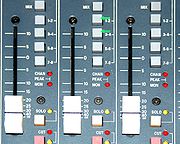
Stem mixing and mastering
Encyclopedia


Some people consider stems the same as separation mastering although others consider stems to be sub-mixes to be used with separation mastering. There is some lack of clarity with regards to what is a stem versus what is a separation. Semantically it seems to depend on how many separate channels of input are available for mixing and/or at which stage they are at towards reducing them down a final stereo mix, with different people drawing the separation line at different places.
This technique originated in the 1960s with the introduction of mixing boards that were equipped with abilities to assign individual inputs to sub-group faders and then manipulate each sub-group (stem mix) independently from the others. This technique is widely used in recording studios to control, process and manipulate entire groups of instruments such as drums, strings, or backup vocals, in order to streamline and simplify the mixing process. Additionally, as each stem-bus usually has its own inserts, sends and returns, the stem-mix (sub-mix) can be processed independently through its own signal processing chain to achieve a different effect for each group of instruments. This technique is also practiced with DAW
Digital audio workstation
A digital audio workstation is an electronic system designed solely or primarily for recording, editing and playing back digital audio. DAWs were originally tape-less, microprocessor-based systems such as the Synclavier and Fairlight CMI...
in a similar way where groups of audio tracks may be processed and manipulated digitally through a separate chain of plugins.
Stem-mastering is a technique derived from stem mixing. Just like in stem-mixing, the individual audio tracks are grouped together to allow for independent control and signal processing of each stem and can be manipulated independently from each other. Even though this method is not commonly practiced by mastering studios it does have its proponents. The advantages and pitfalls of stem mastering are listed below:
Advantages
- More control over each group of instruments.
- Ability to adjust mixes that are out of balance.
- Ability to process each stem through a separate signal chain.
Disadvantages
- Stem-mastering can alter balance of the mix.
- Individual processing of stems may make them sound incongruent with the rest of material.
- Processing of stems adds small amounts of distortions and noise to each stem and thus may magnify the distortions and noise on the entire master proportionally to the number of stems being processed.
Generally well-done mixes do not need stem-mastering as this process potentially magnifies the noise floor and amount of total harmonic distortion
Total harmonic distortion
The total harmonic distortion, or THD, of a signal is a measurement of the harmonic distortion present and is defined as the ratio of the sum of the powers of all harmonic components to the power of the fundamental frequency...
s (THD
Total harmonic distortion
The total harmonic distortion, or THD, of a signal is a measurement of the harmonic distortion present and is defined as the ratio of the sum of the powers of all harmonic components to the power of the fundamental frequency...
).

